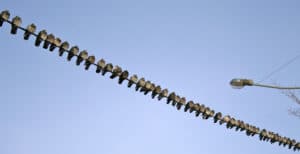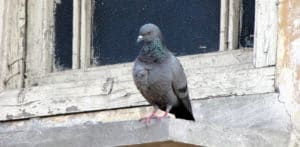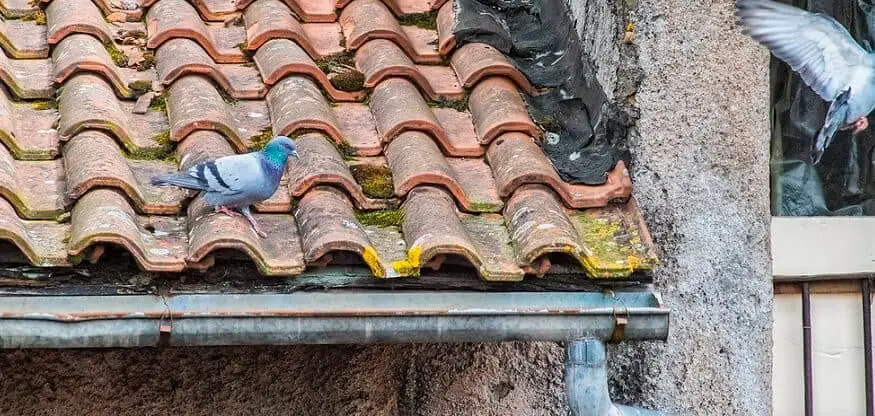Pigeons can be found in nearly every city and town. While they used to be a beloved bird, they have fallen from favor and are now often referred to as “rats with wings.”
When they descend on a home, business, or a park drastic and sometimes extreme measures are often taken in an attempt to scare them away. (New York City has outlawed feeding pigeons and introduced hawks to scare them away)
Sadly, pigeons can be difficult to get rid of and it can become a costly endeavor.
This article will discuss short and long term methods for keeping pigeons away.
Some of the methods are highly recommended in many articles, but this guide will discuss the pros and cons of each method. It will also discuss why pigeons are an issue for many people.
History Of Modern Pigeons
Pigeons used to be a favored bird. They were raised for meat and eggs. They were used for entertainment and to win wars.
Hundreds of years ago, pigeons were tamed and called dovecotes. As domesticated pigeons escaped, they created feral colonies and flocks.
Until recently, pigeons were considered a great source of meat. The average person didn’t have access to imported and shipped meat. Instead, they had to grow it.
Pigeons are very prolific and can reproduce quickly. This made them a good food source. Plus, their meat is high in vitamins. In many areas, pigeon eggs are considered a delicacy. Pigeons were used for meat until chickens emerged as a faster food source.
In World War II and in previous wars, pigeons were used as messenger birds. In fact of the 53 medals given to animals for saving human lives, 32 went to pigeons.
Domestic pigeons were carried to the New World in the 1600s. Because they reproduce so quickly, extra birds were often released into the wild.
Pigeons have no natural predators so they quickly flourished as feral flocks pretty much anywhere they were released.
They tend to especially flourish in the city where food is free and rampant and there are plenty of places to nest.

Why Are Pigeons A Problem?
Pigeons were not considered an issue until a couple of decades ago when a noted journalist labeled them as rats with wings. After that, it only took a couple of decades for them to lose their popularity with the public.
There are many reasons that pigeons are despised today. First, they reproduce quickly. A pigeon couple can have as many as 6-12 babies a year. Since pigeons have a long lifespan, about 6 years, a flock will grow quickly.
Each pigeon produces several pounds of droppings a year. The birds aren’t picky or bothered by their own droppings and use the dung for nests.
Droppings are sticky and work well to cement nests together so it makes it difficult for people to remove without damage to other items. It is also high in acidity so it can damage the paint and other finishes on cars and buildings.
Plus, pigeon droppings can attract ticks and lice, which create other pest problems for people. Excessive droppings in a pigeon attraction can cause trips and slips.
Pigeon poop is also cited as a health issue. Healthy pigeons don’t have unhealthy poop. But, urban pigeons often scavenge and eat many foods and things that have illness and bacteria that can spread disease.
And, because pigeons have such a strong homing signal, they rarely leave an area once they have nested down. Generations of pigeons will return to that spot, turning a little issue into a very big issue.
This is seen in parks, where pigeons were once fed. They can overcome the park and make it less habitable for people to enjoy.
But, there are viable solutions for eliminating pigeons as a nuisance. And, it doesn’t involve eliminating the species.
- Prolific as many as 12 babies a year
- No natural predators
- Each bird leaves pounds of droppings a year
- Droppings can attract lice and ticks
- Droppings ruin the finish on cars and buildings
- Can cause trips and slips on droppings
- Droppings stain because of high acidity
- Homing instinct means that flocks rarely leave on their own.

Difficulties In Getting Rid Of Pigeons
There are many “fixes” that can be found to get rid of pigeons. Unfortunately, many of them only work for a short time, and some of them don’t work at all.
Pigeons are difficult to get rid of because they are very persistent and adaptable. Pigeons will continue to return to a place for years.
That means that when a step is taken to discourage pigeons, it has to be continued for a lengthy time. Pigeons from the flock can continue to come back for years to a location.
If the steps are discontinued and a few straggling birds return, a new flock can quickly populate the area.
Another issue arises if pigeons are attracted to a specific area for shelter or food. If the attraction is greater than the discouragement, then pigeons will quickly adapt.
This is often the case for noise repellents, smell repellants, and decoys. Pigeons will quickly learn that the repellant is not lethal and adjust to it.
But, killing pigeons is often illegal or distasteful to many people. And, poisons are often inhumane.
- Pigeons reproduce quickly
- Some of the flock may leave for a while before returning so repellents need to be for long periods
- Pigeons adapt to non-lethal threats quickly
- Decoys are often ignored quickly
- Lethal methods are illegal in many cities
But, there are many humane ways to discourage pigeon problems.
How To Get Rid Of Pigeons
While pigeons are a problem in many areas, they are also not a problem in many areas. One of the best ways to discourage pigeons is to identify the attraction that brings pigeons to the area.
Like many birds, pigeons look for two main things: food and shelter. The shelter needs to be in a safe area, but pigeons aren’t usually picky parents.
- Get Rid Of Food Sources
- Install Barriers to Nesting Spots
- Add Spikes To Prevent Roosting
- Use Reflective Tape To Disorient Pigeons
- Provide Contraceptive To Pigeon Flocks
- Add Bird Repellent Gel To Repel Pigeons
- Run String To Prevent Resting on Ledges
- Add A Slinky To The Ledges To Stop Perching
- Add Angles of 45 degrees or More To Prevent Pigeons
- Install An Ultrasonic Bird Repeller
- Use Scarecrows To Scare Away Pigeons
- Trap or Kill Pigeons
1. Eliminate Food Sources Attracting Pigeons
Pigeons love a free meal, like any animal. The most common attraction for pigeons is a ready food source. They can generally find a nesting location close to a food source.
Eliminate all food sources. This includes bird feeders. Several styles of bird feeders are designed to only feed smaller birds and won’t allow the larger birds to steal food.
Keep pet food put away. Feed your pets in the garage, or put the food away after they have eaten.
Clean up all food scraps. Keep the compost with a lid on it so that pigeons can’t scavenge. Close the lid on the trash can and keep food scraps cleaned up.
Look around your neighborhood for possible food sources for the birds. Consider talking with neighbors and businesses in the area to eliminate the attractants.
- Eliminate bird feeders or use pigeon proof- bird feeders
- Put away pet food
- Keep compost in a bin with a lid
- Clean up food scraps and other trash
- Work with neighbors to eliminate other food sources

2. Install Screens To Bar Nesting
Pigeons can roost about anywhere. They need very little space. Unfortunately, they can destroy a barn, shop, or house eves.
The next step in getting rid of pigeons is to eliminate their safe spots. Eliminate holes and roosting spots. Place screens over gutter, vents and gaps. Eliminate hiding spots for pigeons.
Hardware cloth or chicken wire can be used to secure empty spaces. Make sure that you screw or staple the screen in place.
Eliminating roosting spots can be difficult because many places that pigeons use are high. But, placing screens over nesting areas and vents will produce more permanent results.
Don’t forget to check your outside window sills, rails, and attic vents. Check the openings for utilities and piping for pigeons. You will also want to check under the eves of your roof, outer buildings, and sheds.
Chicken wire is relatively cheap and easy to install. If you are using chicken wire, make sure to staple it frequently to the area. It will stretch and wrinkle if not secured securely. Chicken wire has little internal structure
- Permanent with little maintenance
- One-time expense
- Can be difficult to install in high or hard-to-reach areas
- Does not harm birds
3. Add Spikes To Roof Eaves To Stop Pigeons From Roosting
Bird spikes have become more popular in recent years. They prevent birds from landing on a roosting spot because they don’t allow room for the birds to perch.
But, they are also slightly and unbecoming to many people. Some people prefer to use bird spikes in harder to see areas so that they aren’t as visible from the street.
Bird spikes come in various sizes and you can choose larger ones that will prevent pigeons from roosting but won’t prevent smaller birds from landing on your home.
Spikes are relatively low in cost but must be securely attached to your home, barn, or garage. They are most often used commercially. They are also used on the eaves, roof and window ledges. They can be found on chimneys, overhangs, and beams.
Other places you can consider installing them include fences, gates, and barns. Bird spikes are generally more permanent than other options and don’t have to be replaced or repaired often.
- Unsightly to many people
- Permanent and needs little maintenance
- One-time cost
- Does Not Harm Birds
4. Use Bird Reflective Tape To Disorient Pigeons
A more temporary option over spikes is bird reflective tape. The tape reflects the light in patterns and colors. The reflection changes as the sun’s position changes.
Bird tape can also be hung in specific areas to confuse pigeons. If it is hung, then the light patterns will change more dramatically with the wind or movement of the tape.
Pigeons don’t like the reflective tape because it confuses them. They don’t have good depth perception and the reflection of the light can partially blind them. It disorients them.
Reflective tape is usually successful.
But, be aware that the tape can rip and shred with time so it will need to be checked regularly and replaced as needed.
Also, you will want to use it in the quantity suggested. If you use too much, pigeons figure out that it’s another decoy and the tape is not as effective.
- Low-cost solution
- Will need to be replaced periodically
- Doesn’t work in the dark
- Not visible to most people
- Doesn’t cause harm or pain to birds
5. Use Bird Birth Control To Limit Pigeon Flock Growth
This is one of the most effective ways to control pigeons is to stop the rapid growth of the flock. Innolytics produces a bird contraceptive called OvoControl. It comes in the form of bird seed. It causes the eggs of pigeons to not hatch most of the time. This limits flock growth.
It is also an ethical way to deal with pigeons and doesn’t involve killing or harming them.
OvoControl feed must be fed to birds on a regular basis to be effective.
In most cases, the main problems caused by pigeons are caused by the sheer numbers of birds in an area.
When the flock population is stalled, then pigeons aren’t a major issue and don’t cause the damage and inconvenience that many pigeons usually cause.
- Humanely prevents flocks from growing
- Keeps pigeon populations in check
- Creates lasting results
6. Add Bird Repellent Gel To Repel Pigeons
Bird repellent gel is scented. In some cases, the scent repels pigeons. But, the gel really works by feel. It has a slick, gritty feel to it.
Pigeons and other birds don’t like the sticky feel on their feet. They usually fly away once they land and feel the gel.
In some situations, homeowners saw the pigeons come back several times and try the gel before permanently quitting the attempts to roost.
Gel will need to be reapplied every 2-3 months in good weather. In poor, wet weather, it will need to be reapplied more often.
It is a popular method because it’s not visible or permanent. That makes it a great solution for renters.
Spikes, tape, and gel can be used together. But, they can also be used solo.
If you use the gel to repel pigeons, make sure you apply the right amount. Too much will catch smaller birds and possibly be dangerous to them. The gel doesn’t come off of feathers and the Humane Society does not recommend using gel as a deterrent.
- Gel feel undesirable to birds when they land
- Gel is not visible
- Doesn’t permanently affect the building
- Not Recommended By The Humane Society
7. Run String To Prevent Resting On Ledges
Another way to keep pigeons away from a specific area is to run a string along a ledge. It should be kept taut and be about 1-2 inches above the ledge. The string prevents birds from resting on the ledge.
This is a fairly cheap and visually appealing method. It doesn’t cost much and can be done with weatherproof string, thin rope, or fishing wire.
But, it does need to be strung in a way that keeps it taut. Otherwise, birds can just land and push the string down or away.
Bird Wire is effective and aesthetically pleasing. It is a more popular method than bird spikes. It can be installed by a professional or done in a DIY fashion. Just make sure that it is installed tightly.

8. Secure A Slinky Along The Ledges
A slinky makes use of the same principle as spikes and bird wire. It prevents the birds from landing on the ledges. The slinky moves and rolls when the bird tries to land.
Pigeons won’t be able to settle or roost on a ledge.
And, slinkies are cheap. They can often be purchased at dollar stores or other discount places.
But, they are more visible than bird wire.
The slinky will need to be attached to the ledge every 6 or 7 loops to keep it secure. It can be nailed, tied, or secured in another manner.
- Slinkies are fairly inexpensive
- Visible to outsiders
9. Add angles of 45 degrees or more to push pigeons off
Pigeons aren’t able to roost or rest on an area that has a 45-degree angle. An otherwise perfect ledge or eave will become undesirable and unusable if it has a 45-degree angle.
Attach wood or metal sheathing over window ledges and flat surfaces. This will keep the pigeons from perching or nesting.
- Sheathing can be more costly, depending on the quantity needed
- Can affect the looks
- Aesthetic sheathing can be more costly than simple plywood
- More permanent solution
10. Install The Ultrasonic Bird Repeller
The ultrasonic bird repeller emits a high-frequency sound that humans can’t hear. Birds can hear it and the sound is meant to bother them and drive them away.
This is lower on the list because it has mixed reviews. The success of the ultrasonic bird repeller depends on the frequency it is set at. It also depends on the specific varieties and flocks of pigeons in your area.
Some flocks are much more used to noise and other frequencies than other flocks. So the level of success will depend on your specific location and the individual bids you are trying to repel.
It is also supposed to help with other pest animals, but the frequency would be different, based on the animal targeted
11. Use Scarecrows To Scare Away Pigeons
Scarecrows have been used in short-term situations to scare away pigeons. The biggest limitation for using a scarecrow is that pigeons will adapt and realize that the scarecrow poses no threat to them.
In order to prevent or delay the flock ignoring the scarecrow, it should be moved frequently. If it’s kept in the same place for long, pigeons will get used to it quickly and return to their normal habits.
Some scarecrows include motion detected reactions. They will light up, make sound, or move when movement is detected.
This helps to scare pigeons away more effectively. Some scarecrows will even stray water in the area covered. This scares away pigeons but can be a hassle if you plan to install it on the roof or other high places.
12. Trap Or Kill Pigeons
Trapping and killing pigeons is one method that is often considered. The main problem with trapping pigeons is that traps have to be monitored and action taken consistently.
Pigeons that are relocated and released can quickly find their way back so euthanizing is the only effective outcome of trapping.
But, the sheer numbers of pigeon flocks makes it a lot of work to trap and euthanize the birds.
And, euthanizing isn’t usually considered humane. Shooting or killing pigeons is illegal in many urban areas.
Is it legal to kill pigeons? In the United States, killing pigeons is illegal in many states under the Migratory Bird Protection Laws. Some states authorize the killing of pigeons specifically as an exception.
In Australia, lethal methods are legal but should be done by professionals. That’s because Australian law is concerned about adult pigeons being killed when it leaves behind young that are dependant on the parents and who will die of starvation.
In the European Union, pigeons can be killed by landowners to protect their crops. Other reasons are illegal. For most, it’s a distasteful task, especially when there are other easier and more humane methods available.
Related Questions
Are Pigeons And Dove The Same Bird? Pigeons and doves are not the same bird, but they come from the same bird family. They both belong to the Columbidae family. Even though they are different species, many people refer to them interchangeably. Just like pigeons, doves lay several clutches of eggs a year and reproduce quickly. Plus, a common pigeon is referred to as both a rock dove and a rock pigeon.
The confusion comes from scientific nomenclature, the process of categorizing animals. In English, we differentiate doves and pigeons as different because of their size difference.
However, automatically, they are basically the same bird. Doves have a much better reputation than a pigeon. So if you hate the bird, it’s likely you’ll call it a pigeon. If you enjoy them, you’ll probably call the flock doves.
How Do I Keep Pigeons Off My Roof? Pigeons can be best kept off your roof by first assessing the type of roof you have. If you have a sloped roof that’s a 45-degree angle or more, then you should watch for the flat areas. Eaves and ledges are the most common areas for pigeons to roost.
If your roof is flat, then there are many more places for pigeons to roost. You will need to use a variety of methods to keep pigeons away. Consider covering the area with bird wire and distributing a contraceptive. This will both help to keep pigeons from nesting on your roof and reduce the total burden of the flock over time.
Can I Kill Pigeons With Rice? Pigeons won’t die from rice. Uncooked rice takes a long time to absorb liquid. By the time the rice has absorbed enough water to swell, the pigeons will have already passed the rice through their system. Using rice is more likely to keep attracting pigeons than to ever eliminate the problem.
Does Alka-Seltzer Work Against Pigeons? Alka-seltzer does not kill pigeons. It used to be believed that the anti-acid would foam and because birds can’t pass gas, they would explode. Besides being a horrible way to die, it doesn’t work. Birds simply regurgitate the foamy mess back up the same way they feed their young already-eaten food.
Feature Image Credit: Franco Bianco


